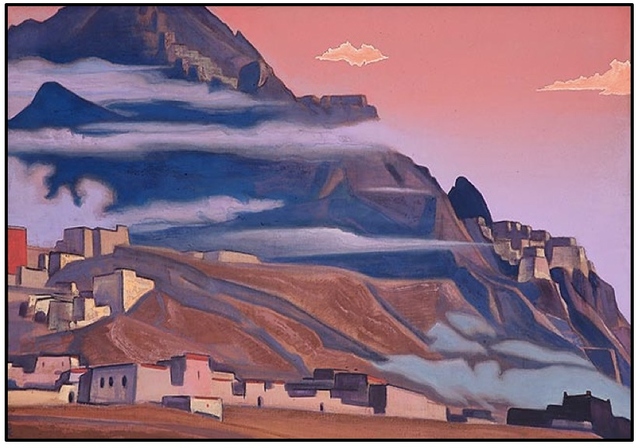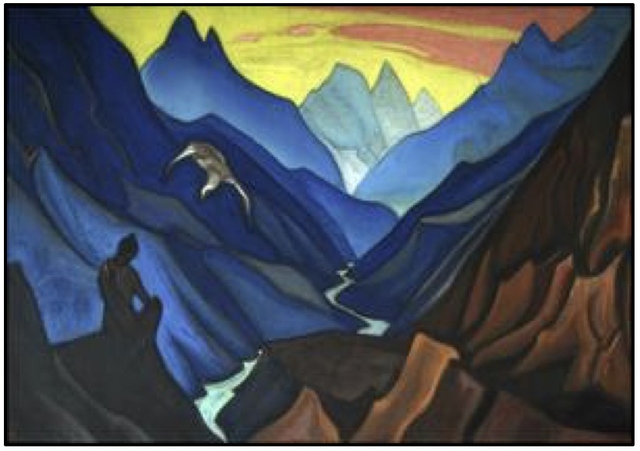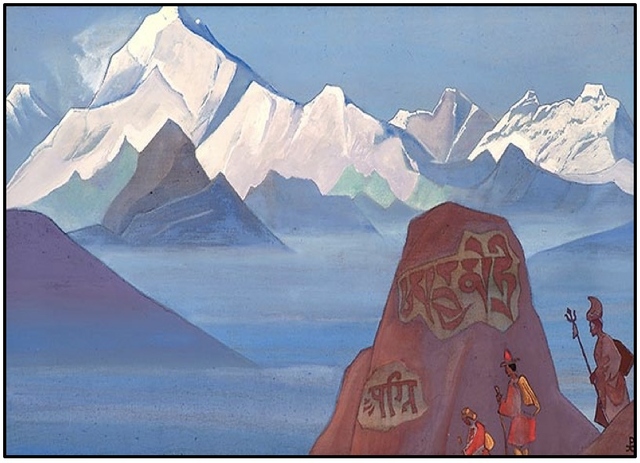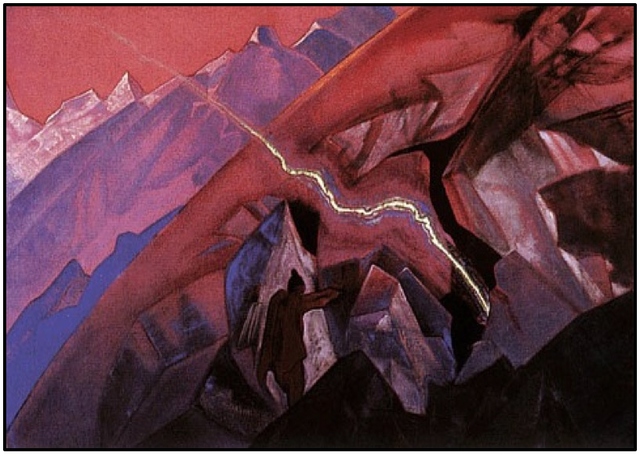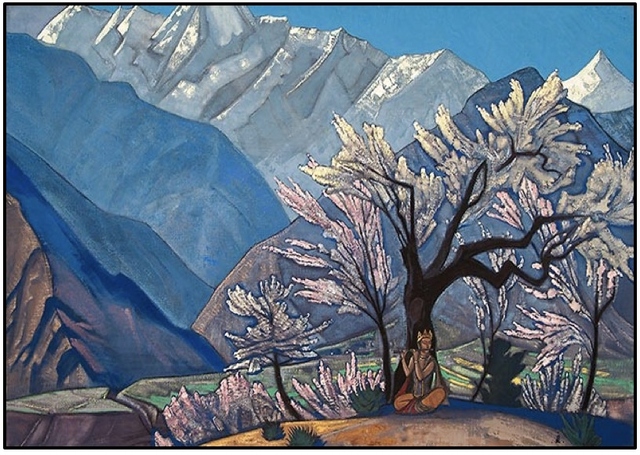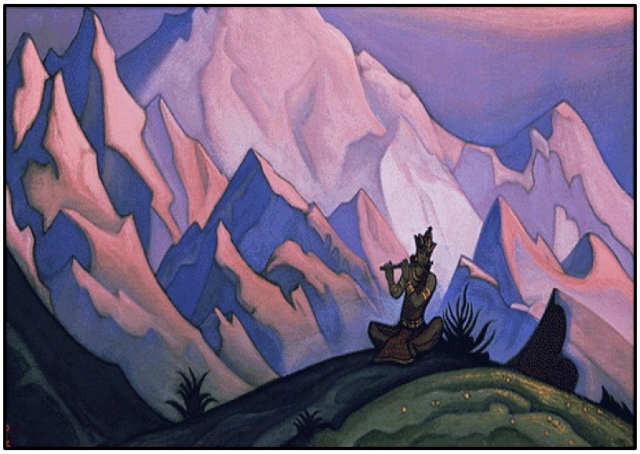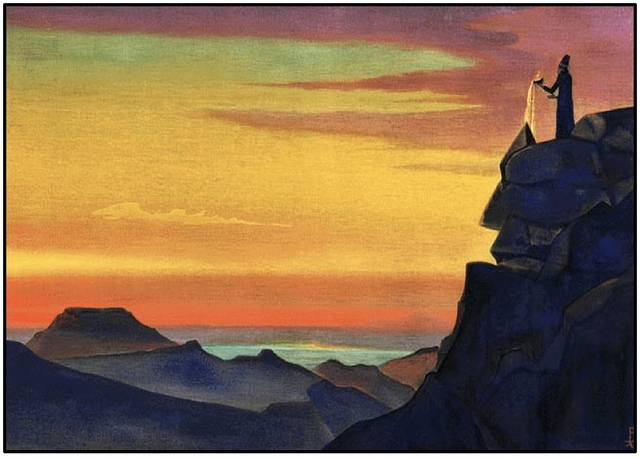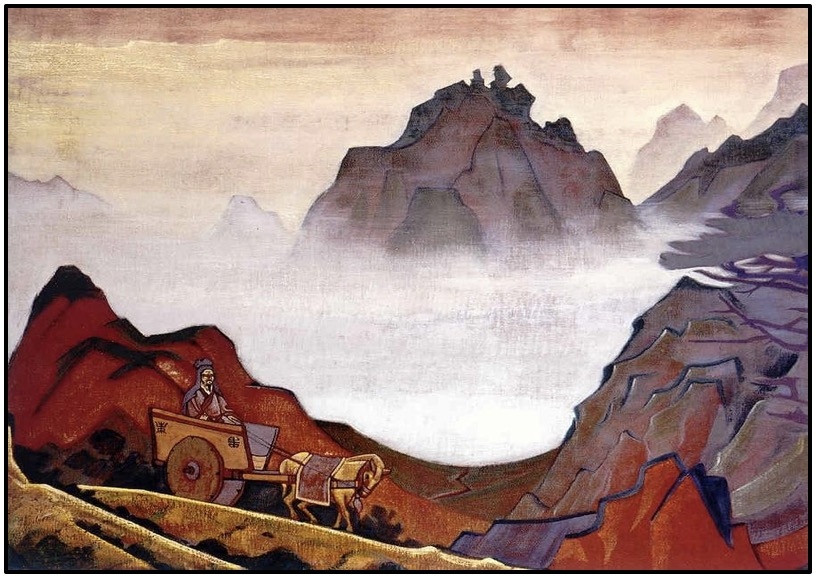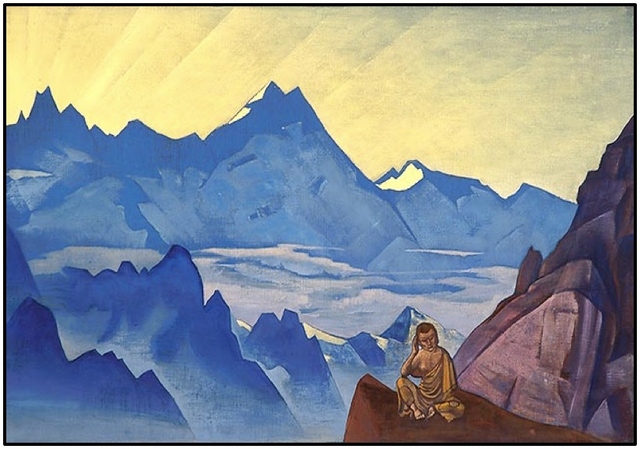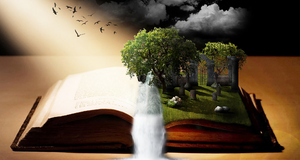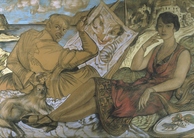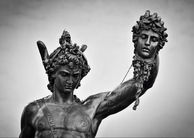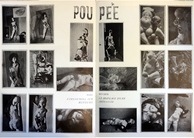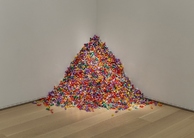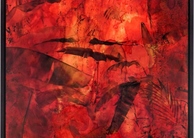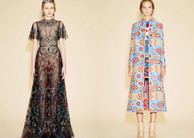Cultural Misrepresentation of the East in Nicholas Roerich's Art
By
2021, Vol. 13 No. 02 | pg. 1/1 AbstractNicholas Roerich was inspired by the mystical concept of “Shambhala”—a utopian expanse of endless truth, knowledge and peace—and his paintings of Asia in the period 1923-1947 attempt to portray the pursuit of this utopian land in diverse Eastern traditions. While several scholars have praised his work for its unconventional style and unique message, I argue that his art fails to live up to the true nature of Eastern cultures and religions and instead distorts them. Through a detailed analysis of a selection of Roerich’s paintings from this period, I show that cultural misrepresentation occurs due to the deliberate unification of disparate Asian traditions into a single thematic framework, and in the physical and philosophical exoticization of Asia and its people. The net effect is that his art functions as a Western, orientalist interpretation of Asia rather than as an authentic depiction. An awareness of the artistic processes resulting in misrepresentation in Roerich’s repertoire is vital in that it helps us recognize the lasting effects of Western hegemony on art, and in turn, identify the means to make way for a more genuine approach in the future. Nicholas Roerich, a 20th-century Russian artist, travelled within India and parts of Central Asia including Tibet, Sikkim, Mongolia, Chinese Turkestan, and Altai in the years 1923 to 1929 (Lansbury, 1974, pp. 9–10). His travels inspired his paintings, in which he visually depicts the diverse Eastern cultural, spiritual, and religious ideas he came across and imbibed. These ideas are drawn from teachings of Hinduism, Tibetan Buddhism, as well as other Eastern religions and systems of belief. Roerich’s culturally rich paintings have allowed artists, critics, and lay observers to understand his “great thirst for knowledge” and “deep appreciation of beauty in all its forms” (Decter, 1989, p. 9). Roerich’s paintings in this period are primarily idealized landscapes, all set in Asia, high up in the Himalayan mountains. Their theme is largely spiritual, with human figures (if depicted) shown in a religious context. Roerich was greatly influenced by the mystical belief in a utopian kingdom—“a place of universal wisdom and ineffable peace”—hidden from but awaiting all worldly beings in the future, a belief present in numerous Asian traditions (LePage, 1996, p. 4). This golden land (and time) is referred to as Shambhala in Hindu and Tibetan Buddhist traditions, with the ruler of this kingdom named Maitreya in Buddhism and Kalki in Hinduism (LePage, 1996). Although the “mystery of [Shambhala’s] location” is unsolved, it is believed to be concealed in the “great mountain ranges and vast deserts of Middle Asia” (LePage, 1996, pp. 15–16). Roerich maintained that “Shambhala is believed to be the earthly link to heaven and that its realm on earth is a secret valley somewhere deep in the Himalayas” (Decter, 1989, p. 140). In his book Heart of Asia, Roerich (1990) affirms his belief in the concept of Shambhala and views it to be a unifying symbol for all of Asia. He says:
Roerich’s view that Shambhala is the most important message of Asia manifests in several of his paintings. Roerich’s admiration of the idea of Shambhala led him to create artistic renditions of the human pursuit of this place of “all-seeing knowledge” and “great inner forces” (Roerich, 1990, p. 88). He visually depicts both the physical pursuit undertaken in search of the mythical kingdom, and the mental, emotional pursuit to achieve a heightened state of spiritual consciousness. Roerich’s artistic representation of Asia has primarily been received positively by artists and critics. His unique goal of using art to unify the ideals of beauty, spirituality, and peace has been lauded. Edgar Lansbury (1974), curator at the Nicholas Roerich Museum, New York, believes that “in [Roerich’s] paintings of the Himalayan period,” we get to see his “singular kind of purpose and striving” (p. 6). Partha Chatterjee (2009), an Indian artist, considers “Roerich’s world [to be] one of contemplation, of looking inwards, of realising oneself and thereby one’s potential” (para. 15). Roerich’s departure from Western artistic conventions and his ready adoption of Eastern influences has also been appreciated. According to Indian art historian Manju Kak (2013), “his work has seen unqualified admiration in India ... [for his paintings] symbolize that which Indians hold close to their spiritual consciousness – the mighty Himalayas” (pp. 16–17). Roerich, in depicting varied Eastern cultures, wished to express the “integration and cultural continuity” of India and Asia (Shaposhnikova, 2013, p. 61). However, a handful few scholars do depart from the majority reaction of awe and praise toward Roerich’s art and beliefs. John McCannon (2013), a historian who studies Roerich’s life and works, asserts that it is wrongly understood that “unconditional love” and “undiluted praise” were Roerich’s only emotions in relation to India and the East (p. 110). He believes that Roerich’s attitude toward Asia was “complex” and multidimensional, going beyond what we see as innocent, wholehearted appreciation for Asian wisdom and virtue (McCannon, 2013, p. 110). In his essay “Conditional Love,” McCannon (2013) explains:
McCannon is clearly critical of Roerich’s assumed stance of superiority and self-righteousness in relation to Asia. Although Roerich presents a seemingly admirable image of deep love and respect for Asian cultures, the reality is that he does not assimilate and adopt Asian cultures as his own—he very much maintains the more typical position of a European outsider who is aware of Western hegemony over the East (McCannon, 2013). In light of the above views, I argue that Nicholas Roerich’s paintings are not free from problematic aspects dealing with the purpose and nature of cultural representation that tend to arise when an artist (or creative individual) represents a culture or tradition foreign to their own. This essay discusses the issues of cultural and religious misrepresentation in Nicholas Roerich’s portrayal of Asia, as seen in several of his paintings in the period 1923–1929 and in the years that followed until his death in 1947. Cultural misrepresentation and distortion in Roerich’s paintings is seen in his fervent attempt at a synthesis of diverse Eastern traditions and faiths into one unified framework, and in his physical and ideological exoticization of Asia into a mystical land. I also argue that these processes of synthesis and exoticization result in Roerich’s art functioning as a Western (European) interpretation on Asia, rather than as a domestic, authentic approach. This essay will attempt to explain how these representational issues manifest in his art, and reference a suitable selection of his paintings to justify the above assertions. Roerich, in channeling his spiritual beliefs to art, presents a fusion of the various cultures sharing in the Shambhalian concept. He portrays religious figures and leaders from different religions, including Hinduism (Krishna, Arjuna), Buddhism (Buddha, Maitreya), Zoroastrianism (Zarathustra), Confucianism (Confucius), to name a few. Besides important figures, he also depicts saints and common people (usually in some state of spiritual pursuit), as well as monasteries and citadels. However, he depicts all these culturally and regionally distinct figures in the same setting in his paintings, that is, amid the backdrop of the Himalayan mountains. Even though the Himalayas are only a small part of the whole of Asia and not representative of the entire continent, he shows these diverse traditions existing and flourishing in this unique, remote, and hard-to-access environment. This is a direct expression of his learning that “[i]n Sanskrit, in Hindustani, in Chinese, in Turkish, in the Kalmuk, Mongolian, and Tibetan languages, and in many minor Asiatic tongues the same ideas, the same indications concerning the Future are expressed” (Roerich, 1990, p. 91). As a result, his art comes across as a deliberate attempt to unify multiple Asian traditions into one coherent whole that smoothly merges beliefs from the contributing faiths. Thus, this leads to cultural misrepresentation, since, in reality, the cultural and religious pluralism of Asia is extremely complex and cannot be simplified and reduced in the manner of Roerich’s art. The second issue is that Roerich tends to idealize and exoticize the Asian (again, predominantly Himalayan) environment and the people he represents. He uses a diverse, unconventional palette to construct his landscapes. His paintings are filled with unearthly colours including bright white and shades of pink, magenta, purple, orange, and cyan. He distributes the colour in his paintings in a highly opaque, dense, and saturated manner. This makes his rendition less lifelike and instead gives it an imaginary, glowing quality. Roerich also focuses less on forms and details and creates simplistic structures. For instance, he uses free flowing lines to draw clouds and rivers, and combinations of geometric shapes to depict mountains, rocks, stones, and buildings. His brushstrokes are flat and evenly spread out. Two good comprehensive example works comprising these features are “Shekhar Dzong” (1933) [Figure 1] and “Command of the Master” (1947) [Figure 2]. All the above features aid in the creation of an idealized, unblemished surrounding. They also give his paintings an overall homogeneity and uniformness, both within a single painting and across his repertoire of paintings. Partha Chatterjee (2009) notes in his article “Roerich Legend”: “His paintings, with or without human figures, have an otherworldliness that can move even the most skeptical of viewers. They are suffused with a glow, and the colours sing” (para. 4). Additionally, Roerich also uses appropriate titles for his paintings so as to evoke in the viewer a spiritual, divine connection in relation to the place and subject being depicted. His titles include words such as path, spirit, treasure, master, message and messenger, darkness and light—all signifiers of a mystical realm. These formal artistic decisions made by Roerich aid him in conveying the message of Shambhala to the world, and in portraying Asia as a spiritually significant land for being the home of Shambhala. However, Roerich’s spiritual and religious interpretation of Asia (through the idealization of the Himalayan landscape and people) leads to problems of misrepresentation, both physical and philosophical, that is, geographical and cultural. Roerich’s heavy reliance on the Himalayan setting biases his geographical representation of the continent. His consistent, repeated use of the same background in numerous paintings reinforces this bias in the mind of the viewer. He likens Asia to the Himalayas, when in fact the Himalayas (and its inhabiting cultures and lifestyles) is only an extremely specialized subset of the continent. Second, his undue focus on the sole theme of Shambhala in relation to Asia reduces the entire continent to a single spiritual concept, and forces observers of his paintings to view Asia only through a religious, mystical lens. Ironically, we start to view Asia the way Roerich and other believers view the concept of Shambhala—as a utopian, ideal, exotic part of the world that serves as an endless oasis of knowledge, beauty, and peace. Roerich’s idealized representation is not an accurate picture of Asian traditions, which comprise more than their exotic dimensions, and affect the day-to-day reality of people in more ordinary, practical ways. In the broader scheme of things, Roerich’s efforts to convey his religious theme lead to a unidirectional artistic focus. They undervalue the true diversity of thought, action, and disciplines present in the Asian continent and in the East. His art leads to a cultural romanticization of Asian culture and people, and a significant reduction of all that Asia stands for. Let us consider Roerich’s 1932 painting “Path to Kailas” [Figure 3]. The painting depicts a few pilgrims trekking in the rugged terrain of the Himalayan mountains, a few peaks of which are shown in the background. The title of the painting suggests that their destination is the Kailas mountain, a religious site for both Hindus and Tibetan Buddhists (Encyclopædia Britannica, 2013, para. 2). In the foreground, a stone structure stands out, with two phrases in two different languages carved into it. Jacqueline Decter (1989), a scholar of Russian literature, describes the artwork as follows:
The phrase Om Mani Padme Hum is originally a phrase in the Sanskrit language; however, it is a mantra associated with Tibetan Buddhism, and not with Hinduism. Hence, both phrases carved onto the rock are associated with Tibetan Buddhist tradition. However, Roerich chooses to describe each phrase in a different language—Om Mani Padme Hum in Sanskrit, and Maitreya Sangha in a Tibetan script. As a result, the consistency and link between the language used and the corresponding culture the phrase is associated with is broken. There is a lack of clarity to the inexperienced viewer as to whether Roerich is trying to portray words of two different religions, or of only one, since Sanskrit is the language conventionally associated with Hinduism. The Sanskrit script placed alongside the Tibetan one seems to imply that Roerich is deliberately trying to unify two separate languages and religions. Moreover, the surroundings in the painting lack the regional specificity to correctly inform us as to which religion is being referred to. This confusion is neither clarified by the nonspecific title of the work. Thus, in neglecting to match the script with that of the geographical location and associated religion, Roerich seems to project the Himalayas (and, as a consequence, Asia) as a site for the perfect union of diverse Eastern religions. Though ideal, this does not match reality—the Himalayan range is areally vast, and a certain Asian religion or tradition would be predominant at a specific location or altitude in the Himalayas. Let us now consider Roerich’s 1929 painting titled “Arjuna” [Figure 4]. In Hindu mythology, Arjuna is a brave warrior and close friend of Krishna, a Hindu God (Vyasa, 400–301/1883–1896). The painting shows the “disciple” of Krishna “blasting a path through the mountains” (Decter, 1989, p. 185). The backdrop is the Himalayas, as in “Path to Kailas,” however, here it is portrayed in a manner that is less realistic. The mountains are rendered in deep magenta and purple hues, instead of in white or grey as would be expected. The painting shows Arjuna using his powers to break open a path through the mountain. This explains the oddly-shaped rock structures surrounding the “lightning-like beam of energy” that emerges from their interior (Decter, 1989, p. 185). The astonishing human action being depicted in the painting, in combination with the enchanted look of the surroundings bestows the whole work with an ethereal tone. Moreover, Roerich’s placement of Arjuna in a Himalayan setting is unconventional, as that is not the regular location associated with Arjuna. According to Hindu mythological legend (specifically, the epic poem The Mahabharata), Arjuna only travels to the Himalayas at the very end of his life (Vyasa, 400–301/1883–1896, Book 17: Mahaprasthanika Parva, Section 2, para. 1). Conventionally, in art, Arjuna is shown on the battlefield as a participant of the Kurukshetra War, as that is considered the most significant moment in his life. Hence, here we see Roerich departing from traditional Hindu legend and taking the artistic liberty to place Arjuna in an unusual, eye-catching setting. This decision is understandable considering his aim of emphasizing the importance of Shambhala—he brings together disparate Asian faiths into a common Himalayan setting to underscore Asia’s role as a cultural and religious nerve centre for the rest of the world. Similar observations can be made from Roerich’s 1930 painting “Krishna” (From Kulu Series) [Figure 5] and his 1946 painting “Krishna” [Figure 6]. Both paintings depict the Hindu deity Krishna playing his flute in an idealized, romantic Himalayan setting. While the portrayal of flute-playing is in line with Hindu legend, Krishna, like Arjuna, is not conventionally associated with the Himalayan region. In fact, he is even more removed from it than Arjuna, since there is no mythological legend that speaks of his travel there. Krishna spent most of his life in the present-day northern Indian states of Uttar Pradesh and Haryana (Vyasa, 400–301/1883–1896). Thus, we see an example of distortion in religious belief in the geographical placement of the figures of Krishna and Arjuna. These characters are displaced from the areas they are commonly associated with (and where they are worshipped) to an unfamiliar, exotic location that most Hindus would find it hard to associate them with. This also leads to an inaccurate impression of Hinduism on the uninformed viewer—Roerich’s representation seems to imply that Hinduism is predominantly practiced in the Himalayas, when this is not the case. We see the same lack of cultural and religious specificity that we see in “Path to Kailas,” as well as a lack of narrative mythological context in Roerich’s portrayal of religious figures. Along the same lines, let us consider Roerich’s 1931 painting “Zoroaster,” his 1925 painting “Confucius The Just One,” and his (also) 1925 painting “Milarepa, The One Who Harkened” [Figures 7, 8, and 9, respectively]. Each painting depicts a leader or notable figure of a distinct Eastern religious tradition: Zoroaster (of Zoroastrianism), Confucius (of Confucianism), and Milarepa (of Tibetan Buddhism). In all paintings, the figures are placed in similarly fanciful, mystical mountainous settings. Zoroaster “stands atop a high cliff holding [a] sacred chalice” with “divine fire” emerging from it (Decter, 1989, p. 188). Confucius “rides in a wooden horse-drawn cart through a landscape,” “with a mountain rising out of the mist in the distance” (Decter, 1989, p. 150). Milarepa “sits in meditation on a stone,” “just as the sun is rising above the Himalayas” (Decter, 1989, p. 151). Roerich shows each mythical hero engaging in an act specific to the religion, but places them in very similar settings. This, again, is part of Roerich’s endeavour to show distinct Asian faiths unified in efforts toward the common goal of discovering Shambhala and attaining spiritual enlightenment. Through these examples, we also continue to witness Roerich’s attempts at both a synthesis of different Asian religions and a romanticized projection of the Himalayas as a melting pot of all of them. Roerich’s cultural consolidation process and spiritual exoticization of Asia work together to lead us to view his paintings collectively as a foreign, Western depiction of the East. His paintings lose the genuineness they would have if they instead presented a more realistic, diverse, and culturally and geographically specific depiction of Asia and its different locations and traditions. Roerich’s lack of formal and stylistic variety and his use of an almost standard, predictable design template across his repertoire of Asian-themed paintings reduces their credibility and informational value to both Eastern and Western audiences alike. Moreover, it also reduces Roerich’s authority in the minds of observers; it naturally appears that he might not have immersed in an in-depth cultural and regional study prior to representing a foreign culture. When looking at his paintings, we immediately note a lack of concern for factual, true-to-life representation, and we start to question the artist’s views toward the land and cultures he depicted. Roerich, through his art, comes across as a naïve outsider to his subject, as an unknowing European attempting to discover the wonders of the East. Figure 7: Zoroaster (1931) Figure 8: Confucius The Just One (1925) Figure 9: Milarepa, The One Who Harkened (1925) In the minds of cautious viewers, then, his art too acquires a foreign, outsider status. His vision and representation of Asia are acquired and accomplished, respectively, through a Western lens. The idealized Asia in his art is his own “European invention”—a “place of romance, exotic beings, haunting memories and landscapes, [and] remarkable experiences” (Said, 1979, p. 1). Roerich takes on a position of power and dominance over his imagined Asia, and “articulates” this “silent and dangerous space beyond familiar boundaries” through his artistic choices (Said, 1979, p. 57). Roerich’s self-imposed authority is seen in his decision to paint Asia solely as a sacred and spiritual continent, without regard for the realistic social dimensions of the Eastern world. In other words, his creative representation of Asia masks, “exclude[s],” and “displace[s]” the “real” Asia and is fully independent of it (Said, 1979, p. 21). In defining his own version of Asia, Roerich achieves his desire of introducing and presenting Asia to the West in such a manner as to fascinate, excite, entertain, and discomfort the European viewer, all at the same time. Moreover, Roerich’s artistic license and liberty are directly reflected in his works, and this feeling of dominance rubs onto the Western viewer, who feels a mild sense of superiority in relation to the Asian subject. This feeling of European supremacy and modernity is also enhanced by the simultaneous reduction and dehumanization of Asian cultures and peoples to a purely romantic, unearthly status. The lack of reality and equality (to Western standards) in Roerich’s Asia is well explained in McCannon’s (2013) statement, “Roerich’s India was unspoiled by industrial era ‘progress’ and the grasping acquisitiveness of contemporary commercialism” (p. 113). In taking a closer, detailed look at Nicholas Roerich’s paintings from the period 1923 to 1947, we find examples of cultural misrepresentation and distortion of Eastern (Asian) traditions and religions. These evidences arise through two representational processes undertaken by Roerich: one, the intentional unification of disparate beliefs and faiths into a single, all-encompassing “Eastern” (and “Asian”) faith as envisioned in the artist’s imagination, and two, in the physical and symbolic exoticization of the Asian continent into a spiritual haven. Roerich achieves the above two effects through intentional, unconventional stylistic choices specific to his works. Understanding these representational processes at work is key to realizing that artistic depictions of the East are not free of the effects of the cultural and economic hegemony that the West has enjoyed over the East for centuries. Only when artists step out of the last ravages of Western dominance and fully embrace Eastern identities with all their imperfections and differences can art become truly authentic, natural, and global. ReferencesChatterjee, P. (2009, December). Roerich legend. Frontline: India’s national magazine, 26(25). https://frontline.thehindu.com/arts-and-culture/art/article30185451.ece Decter, J. (1989). Nicholas Roerich: The life and art of a Russian master. Inner Traditions International. Encyclopædia Britannica. (2013). Kailas Range. In britannica.com encyclopedia. https://www.britannica.com/place/Kailas-Range Kak, M. (2013). Introduction. In Manju Kak (Ed.), Nicholas Roerich: A quest and a legacy (pp. 9–23), Niyogi Books. Lansbury, E. (1974). The art of Nicholas Roerich. Kailash: A Journal of Himalayan Studies, 2(1–2), 5-11. https://himalaya.socanth.cam.ac.uk/collections/journals/kailash/pdf/kailash_02_0102_01.pdf LePage, V. (1996). The fascinating truth behind the myth of Shangri-la. Quest Books. McCannon, J. (2013). Conditional Love. In Manju Kak (Ed.), Nicholas Roerich: A quest and a legacy (pp. 109–125), Niyogi Books. National Endowment for the Arts. (2013, April 23). President John F. Kennedy: Remarks at Amherst College, October 26, 1963 – Transcript. https://www.arts.gov/about/kennedy-transcript Roerich, N. (1925). Confucius the just one [Tempera on canvas]. Bolling collection, Miami, FL, United States. Roerich, N. (1925). Milarepa, the one who harkened [Tempera on canvas]. Nicholas Roerich Museum, New York, NY, United States. https://www.roerich.org/ Roerich, N. (1929–30). Arjuna [Tempera on canvas]. Bolling Collection, Naples, FL, United States. Roerich, N. (1930). Krishna (From Kulu Series) [Tempera on canvas]. Nicholas Roerich Museum, New York, NY, United States. https://www.roerich.org/ Roerich, N. (1931). Zoroaster [Tempera on canvas]. State Museum of Oriental Art, Moscow, Russia. https://www.orientmuseum.ru/ Roerich, N. (1932). Path to Kailas [Tempera on canvas]. Nicholas Roerich Museum, New York, NY, United States. https://www.roerich.org/ Roerich, N. (1933). Shekhar Dzong [Tempera on canvas]. Nicholas Roerich Museum, New York, NY, United States. https://www.roerich.org/ Roerich, N. (1946). Krishna [Tempera on canvas]. Location unknown. Roerich, N. (1947). Command of the master [Tempera on canvas]. State Museum of Oriental Art, Moscow, Russia. https://www.orientmuseum.ru/ Roerich, N. (1990). Heart of Asia: Memoirs from the Himalayas. Inner Traditions International. Said, E. W. (1979). Orientalism. New York: Vintage. Shaposhnikova, L. V. (2013). A Caravan in Time and Space. In Manju Kak (Ed.), Nicholas Roerich: A quest and a legacy (pp. 57–72), Niyogi Books. Vyasa (1883-1896). The Mahabharata of Krishna-Dwaipayana Vyasa. (K. Ganguli, Trans.). (Original work published ca. 400–301 BCE). Internet Sacred Text Archive. https://www.sacred-texts.com/hin/maha/index.htm Suggested Reading from Inquiries Journal
Inquiries Journal provides undergraduate and graduate students around the world a platform for the wide dissemination of academic work over a range of core disciplines. Representing the work of students from hundreds of institutions around the globe, Inquiries Journal's large database of academic articles is completely free. Learn more | Blog | Submit Latest in Visual Arts |

